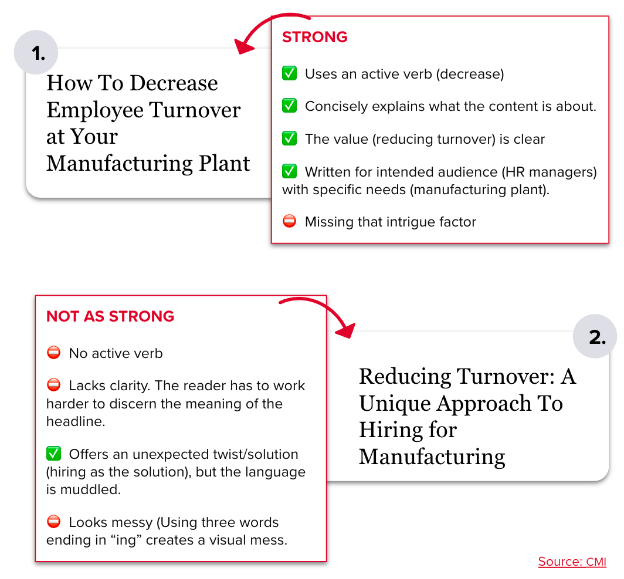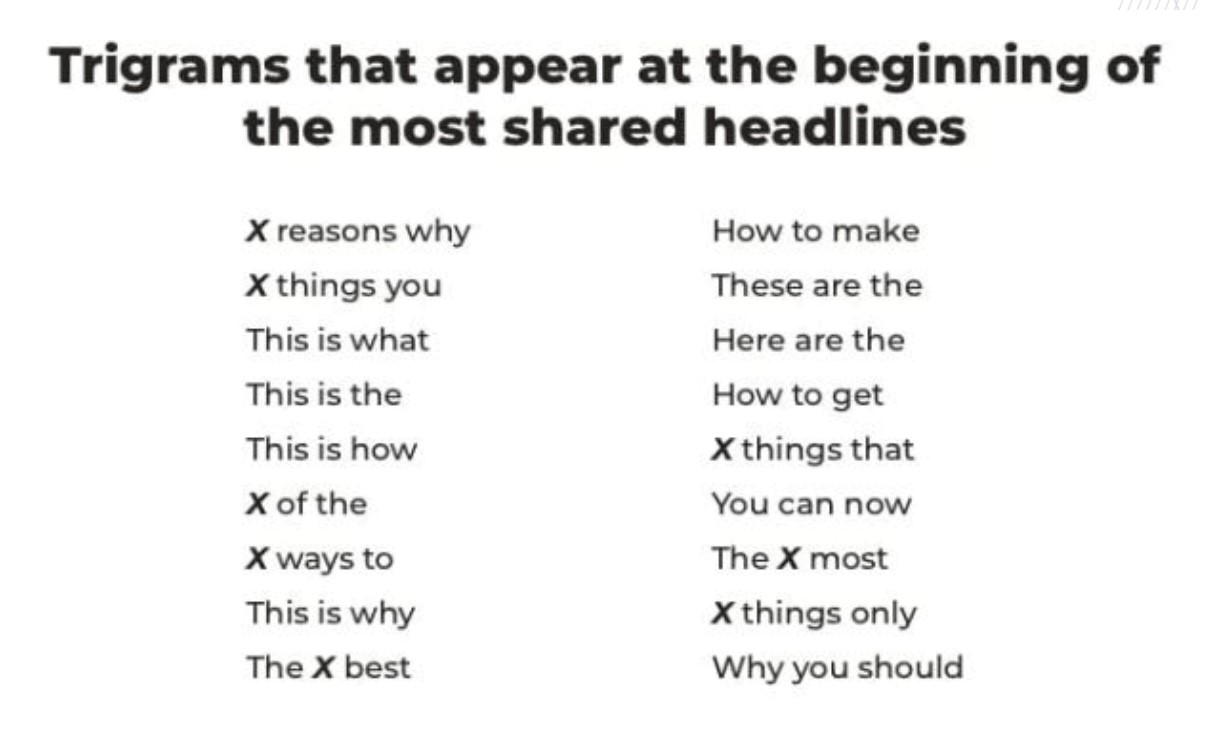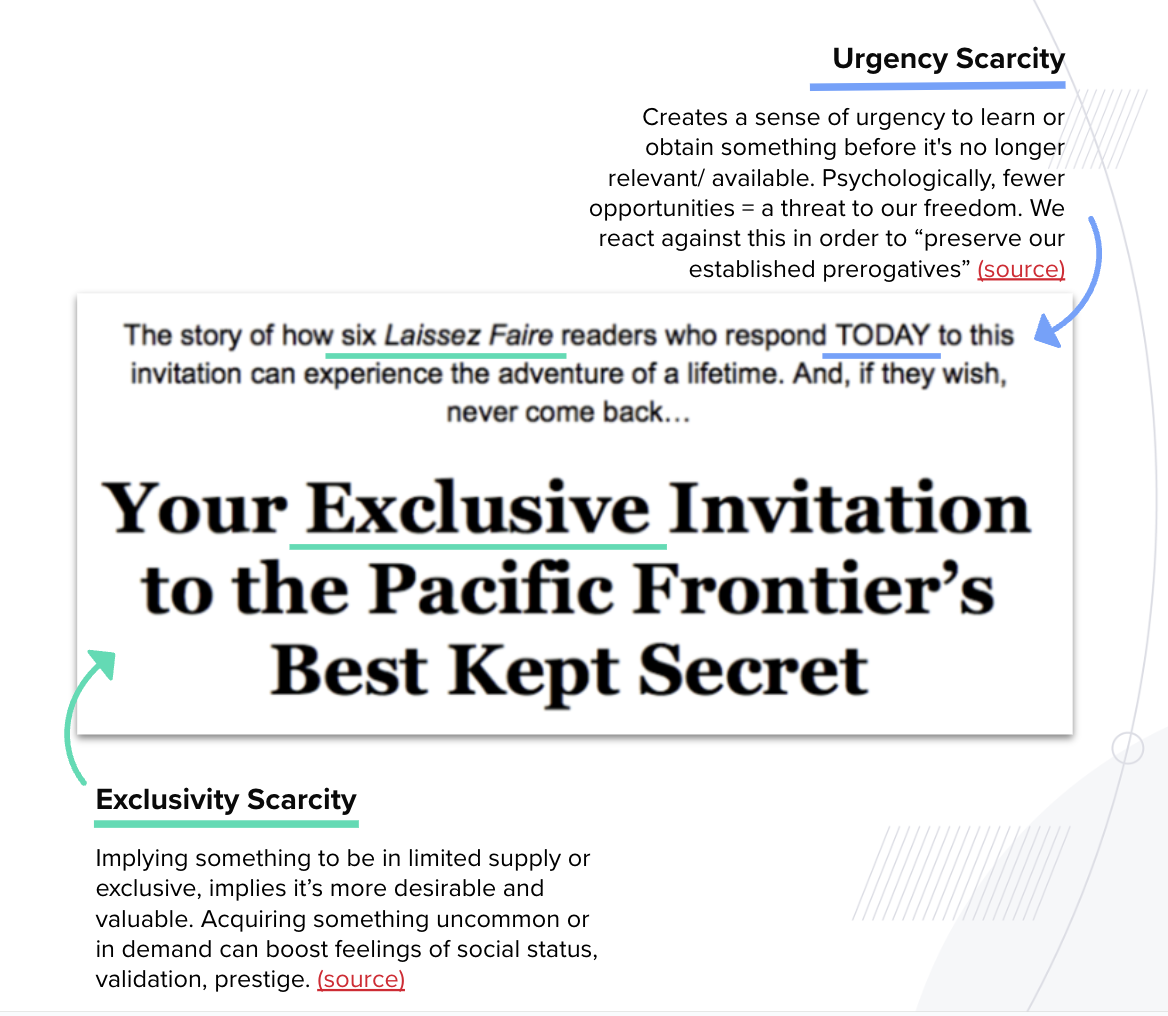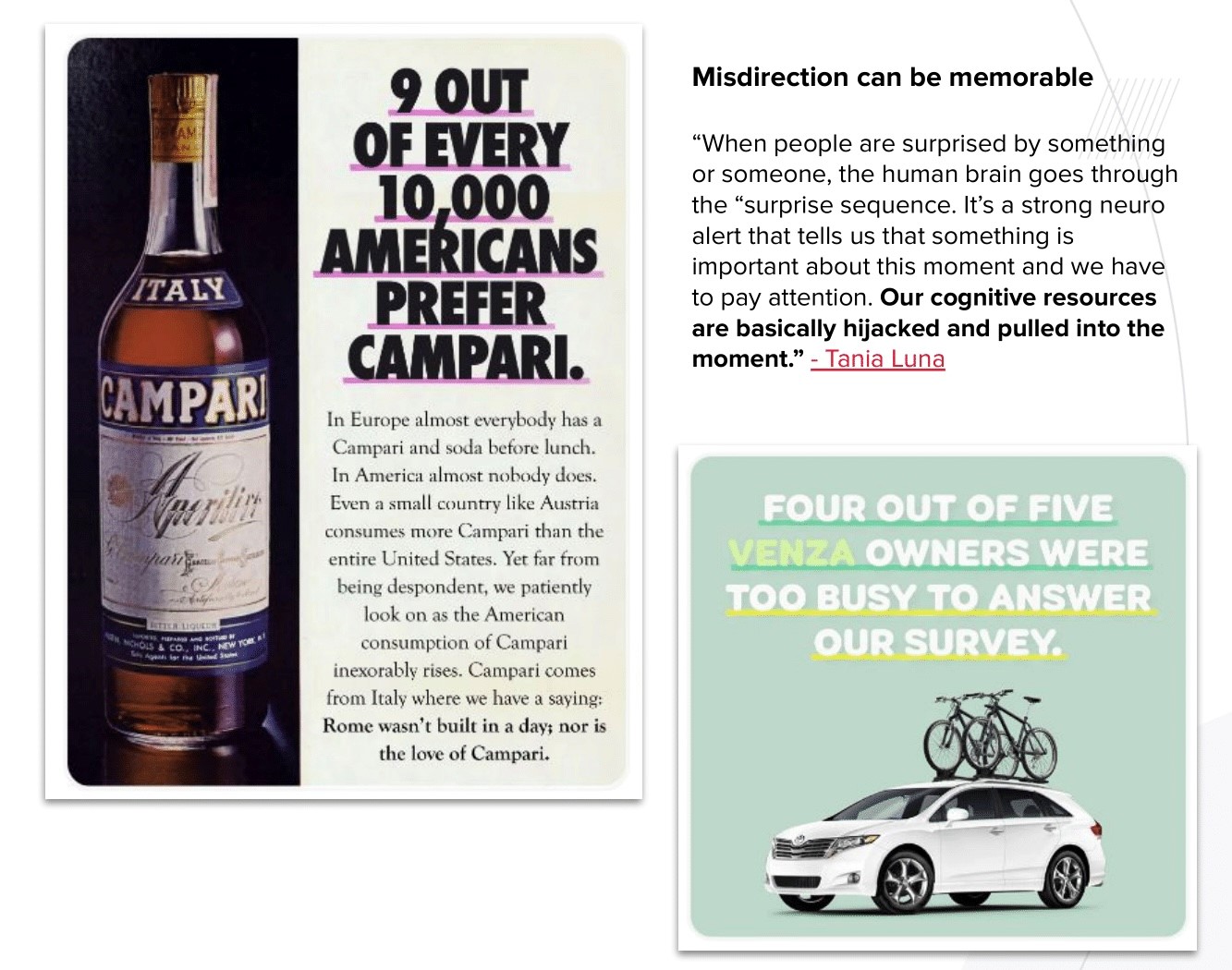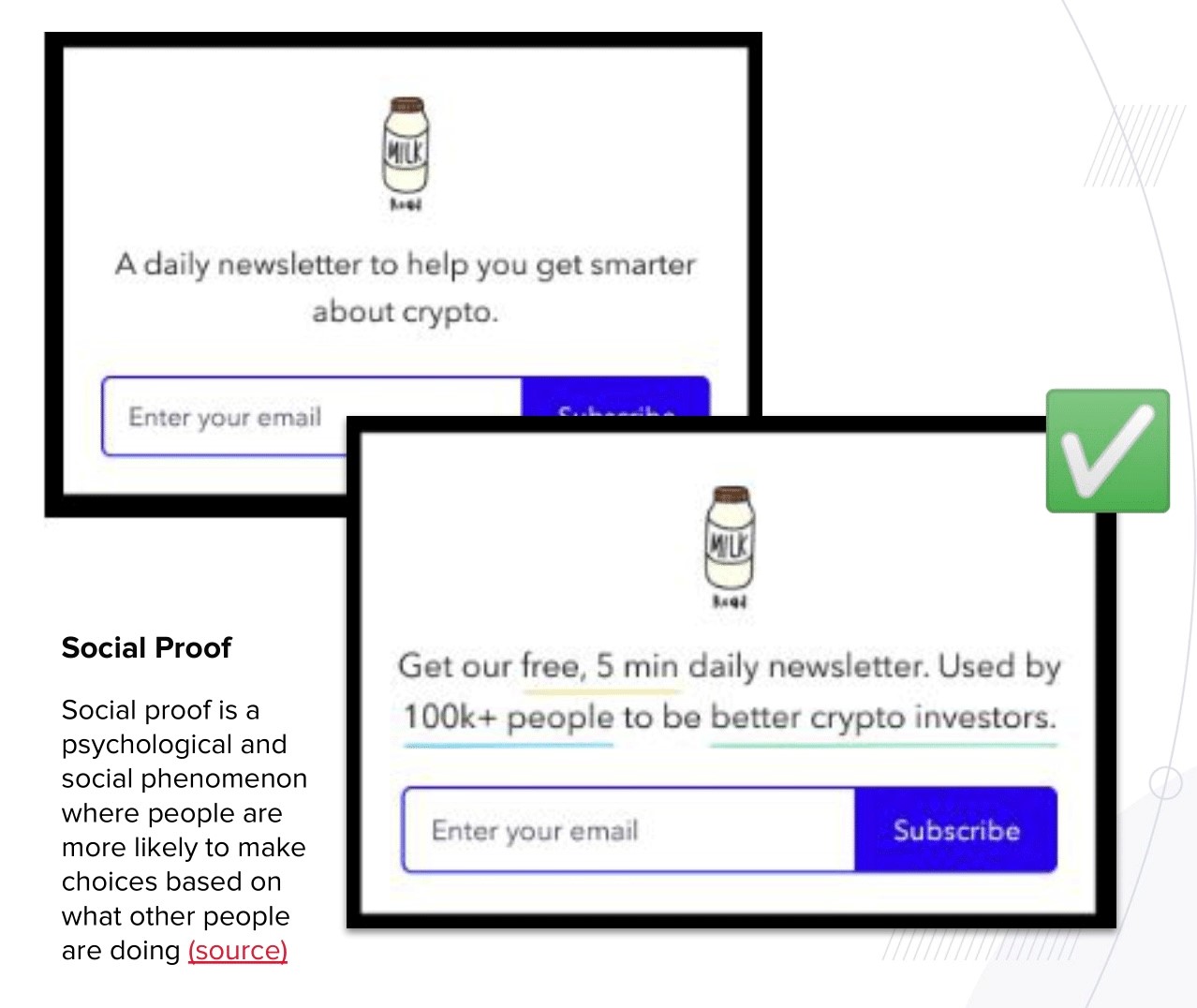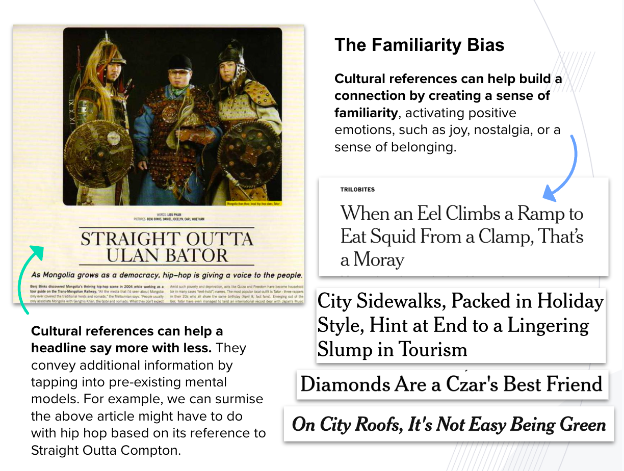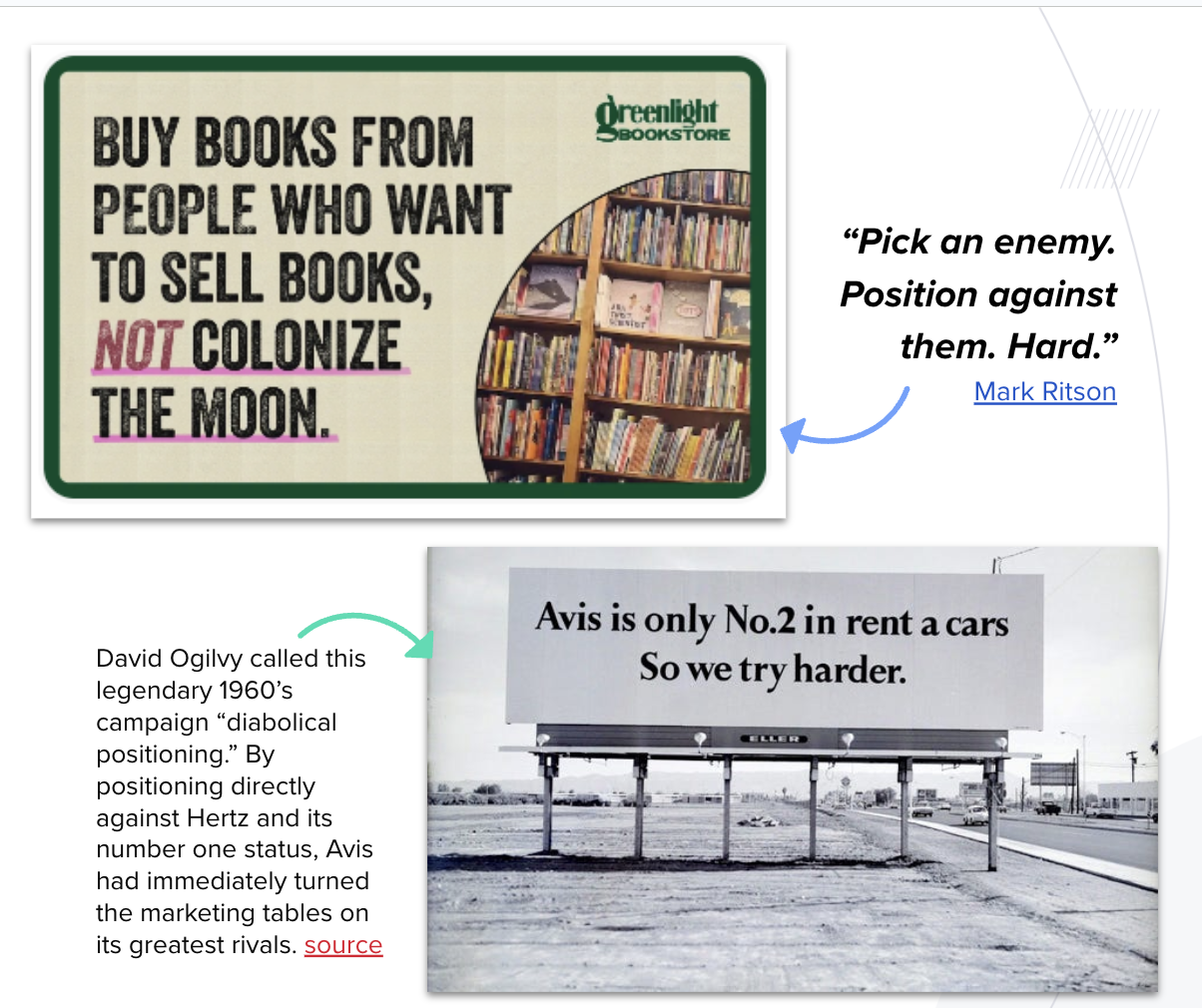Table of Contents
By Melissa Mattoon (Senior Strategist, studioID) and Lieu Pham (VP of Global Strategy, studioID)
At studioID, we publish thousands of headlines each year. And for every one that makes it out there, there are dozens of drafts that don’t. Add to that the countless Slack messages, emails, and quick gut-checks with colleagues that happen along the way. It might sound like an intense process, but in a world overflowing with content, the headline is what stands between your story and the endless scroll of your audience’s feed.
But skim any headline how-to guide on the web, and you’ll likely find two prevailing approaches: the SEO and click-centric tactics of content marketing, and the narrative-driven tenets of journalism.
The best performing headlines are the ones that strike a balance of both.
Drawing from our own insights and experiences, as well as some of our favorite external sources, we’re sharing three evidence-based strategies to help you balance the best of analytics, psychology, and creativity to craft headlines that work.
1. Understand the Building Blocks of a Good Headline
While we encourage experimentation and breaking the mold, there are some tried-and-true elements of high-performance, well-written headlines that should form the basis of your approach. Learn to fuse these components and characteristics, and you’ll arrive at a click-worthy headline every time.
Value: Offer Something You Know Your Audience Wants
First and foremost, start with your audience. You need to have a keen understanding of who you’re talking to in order to offer them anything of value.
Put yourself in their shoes to uncover:
-
What are their challenges?
-
What motivates them?
-
Why should they care about your product or your content?
-
What can it do for them?
Once you’re clear on that, your headline needs to convey a clear benefit to your target audience — whether that’s providing useful information, solving a problem, or entertaining them in some way.
Clarity: Make it Clear and Snappy
The time you have to capture your audience’s attention is exceptionally small. Keep tinkering with your headline until it’s instantly clear and understandable. Make sure your headlines incorporates:
-
Active verbs
-
Concise language
-
Variety
-
Strong syntax (or the arrangement of words)
Let’s look at an example from CMI in action. The audience in the below example is HR professionals in the manufacturing space.
Source: How to Create a Powerful Headline in 7 Simple Steps, CMI
The Good
In the above example, the first headline is strong because it uses an active verb and clearly explains the content’s focus. It speaks directly to the intended audience (HR managers in manufacturing) and offers a clear benefit (how to reduce turnover). While it’s near-perfect, it’s one shortcoming is that it’s lacking a bit in intrigue.
The Bad
On the other hand, the second headline above falls short. It lacks an active verb and fails to clearly communicate the article’s topic. While it does include an unexpected twist/solution, the use of multiple words ending in “-ing” creates a visual mess, making it harder for the reader to understand the meaning of the headline.
Structure: Lead With the Right Words
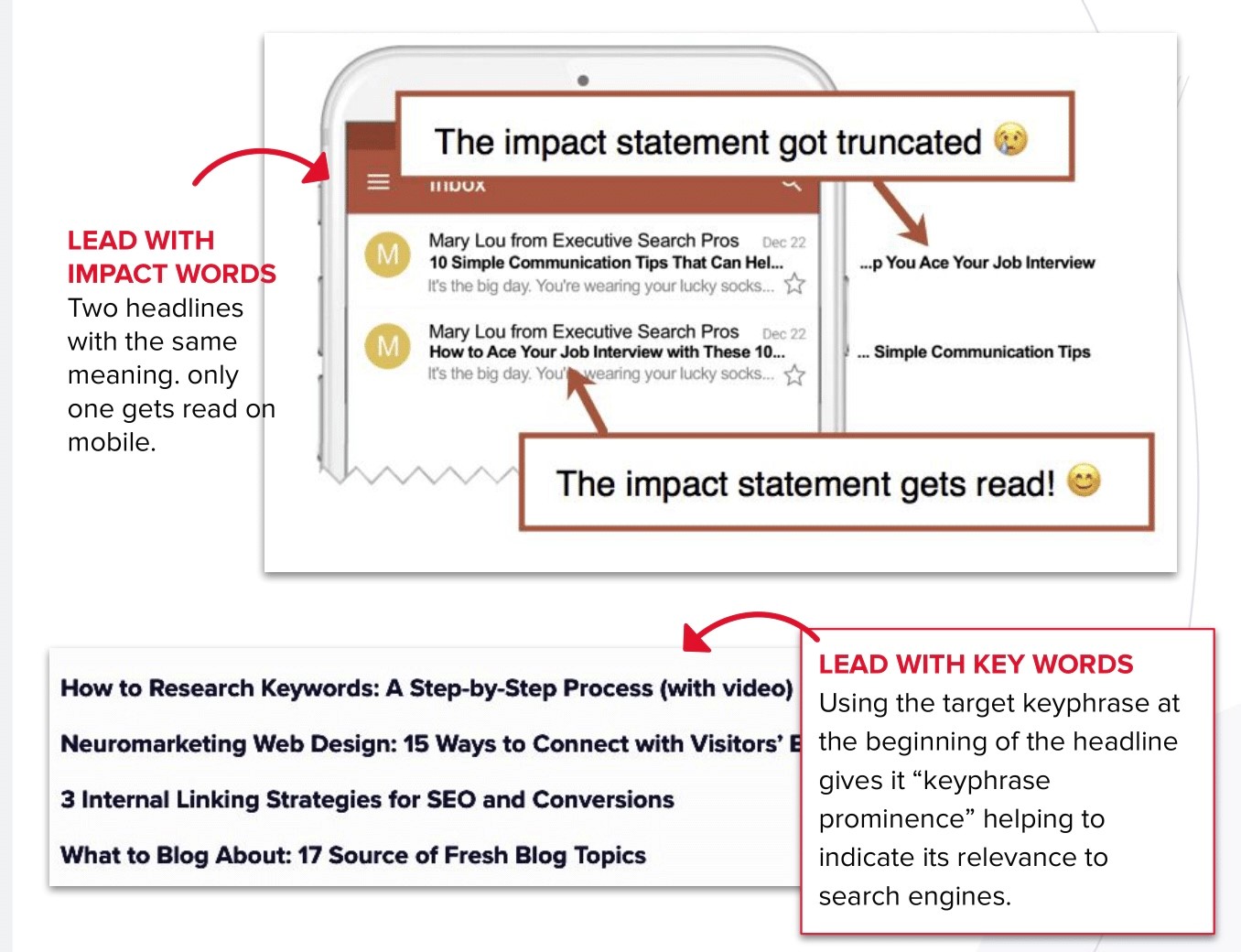
Additionally, this is particularly important for email inboxes — which often truncate long headlines — as well as search engines that also place high value on the keywords in the beginning of headlines. If you want your content to be easily discoverable and engaging, be strategic about the placement of your words.
Engagement Drivers: Incorporate What’s Working
When it makes sense, work to integrate components that are proven to impact engagement. According to Buzzsumo’s analysis, the most successful headlines make use of:
-
Top-performing phrases (like “of the year” or “in X years”)
-
Numbers (the number ‘10’ is the best number to use in headlines)
-
A solid theme/tone (top tones include instructional, time-centric, curiosity-sparking)
Additionally, keep in mind the sweet-spot in terms of length for modern headlines.
Buzzsumo’s analysis found the ideal length of a headline was 11 words or 65 characters.
Numbers
Listicles have become a popular format for creating engaging content, and for good reason. They set clear expectations about the amount of content and the variety of information that will be included, making them easily scannable for readers who want to find specific information quickly.
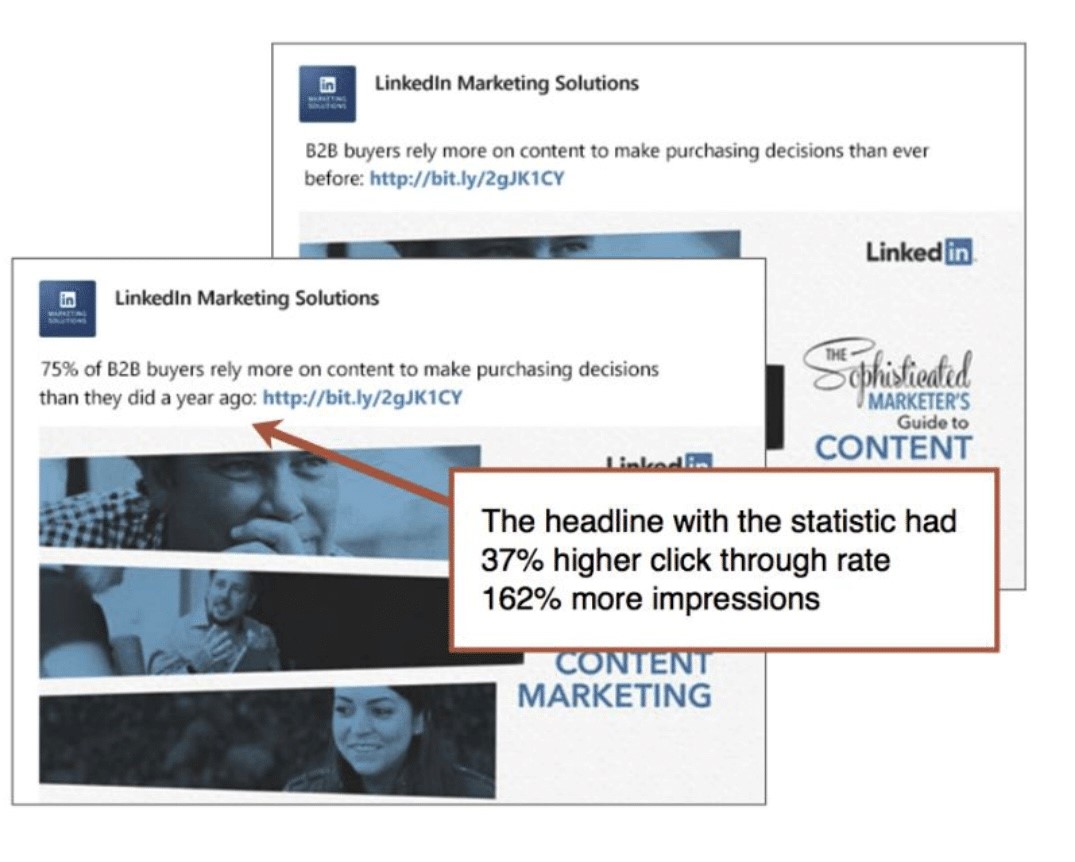
When using numbers, it’s important to be precise and use the actual numeral rather than writing out the word. This not only makes the headline more visually appealing and concise, but also conveys a sense of data-driven research and expertise.
In fact, studies have shown that headlines with statistics or data can significantly increase click-through rates, particularly among B2B audiences who are often motivated by data and research.
Trigrams: What They Are and How to Use Them
Buzzsumo’s research also found that the most compelling headlines had a common feature: a trigram. A trigram is simply a three-word phrase, and certain combinations of three words within headlines appear to be more impactful than others.
Source: Buzzsumo
Let’s take a look at the phrases “This is how” and “This is why”. These trigrams are effective because they confidently present a “how-to” or “why” angle. They also lend themselves well to attention-grabbing headlines, such as “This is why you should love ETFs as much as me” or “This is how democracies die.” Trigrams give off a sense of automatic authority, and in today’s fast-paced world, we can’t afford to get our information from just anyone. We want it from the definitive source.
Start With “What”, “Why”, “How”, or “Who”
Asking a question — or directly answering a question — is a powerful way to start a headline. Even if it’s a rhetorical question that highlights the benefits or a challenge that urges your audience to click, it creates a strong opening. Some of the most effective headlines typically begin with ‘question’ words like “What,” “Why,” “How,” or “Who.”
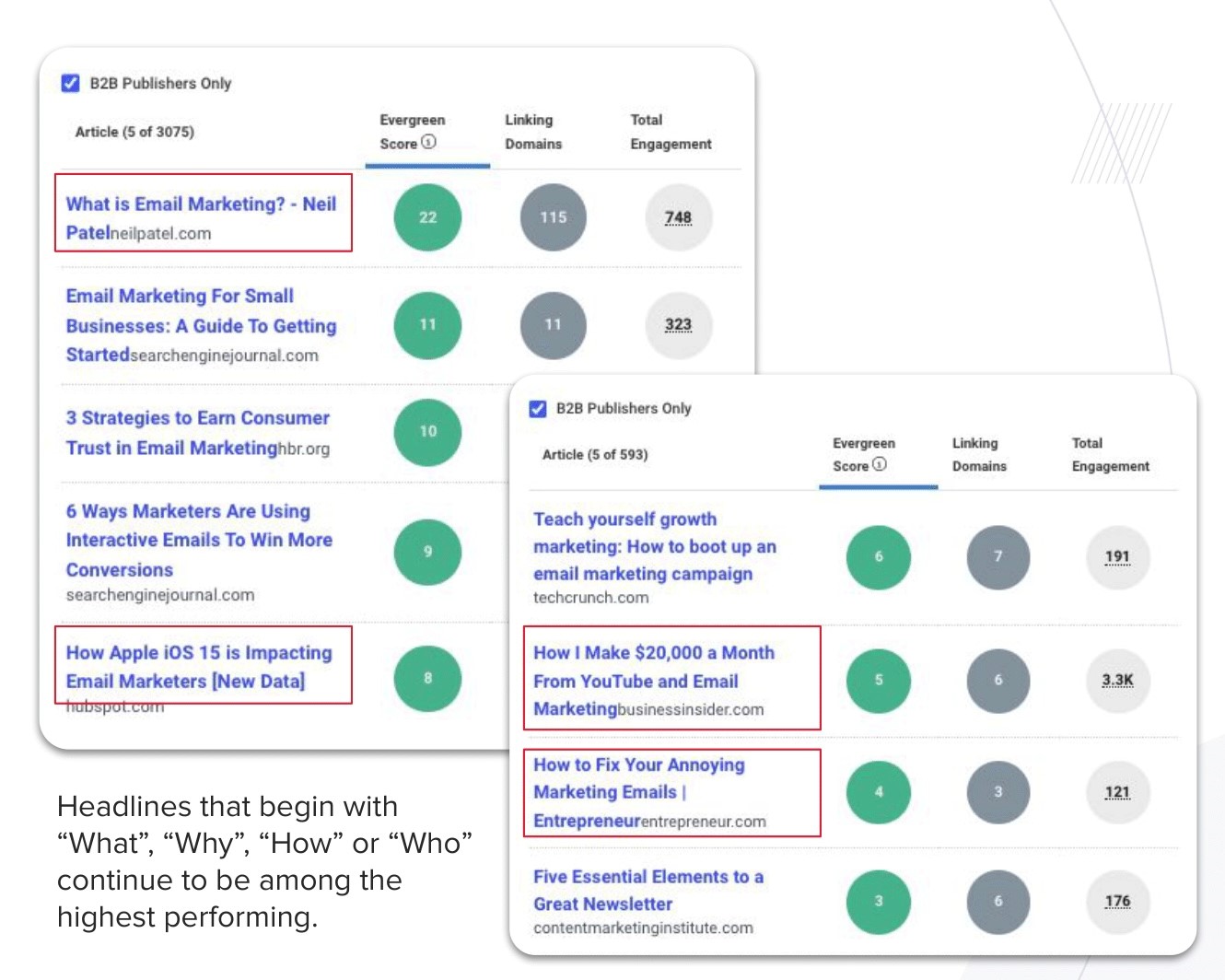
By posing or directly answering a question, you can:
-
Spark your readers’ curiosity/generate interest in the content
-
Encourage them to click through for more
-
Benefit SEO efforts by signaling to search engines like Google that your article is likely to be useful and informative
2. Use Psychological Principles
Odds are, as a marketer, you’re already using social and behavioral psychology instinctively throughout your content. Understanding how to apply these principles to headline writing will only elevate your approach. At its core, marketing is about persuasion after all.
Leverage the Scarcity Principle
The scarcity principle is a theory in economic psychology that suggests people place a higher value on things perceived to be rare, limited, or in short supply. Headlines that create a sense of scarcity around a product or service can motivate consumers to take immediate action.
Understanding the Various Ways to Use the Scarcity Principle
Exclusivity:
Exclusivity scarcity implies limited availability or exclusivity, making the item more desirable and valuable. Acquiring something uncommon or in demand can enhance feelings of social status, validation, and prestige.
E.g. “Your Exclusive Invitation to the Pacific Frontier’s Best Kept Secret”
Urgency:
Urgency scarcity creates a sense of dwindling time to obtain or learn something before it becomes irrelevant or unavailable. From a psychological standpoint, this works because fewer opportunities feel like a threat to our freedom, and we react to preserve our prerogatives. Employing the scarcity principle in headlines is a powerful way to grab readers’ attention and encourage action, but it should be used thoughtfully.
E.g. “The story of how six Laissez Faire readers who respond TODAY to this invitation can experience the adventure of a lifetime.”
Sources: “Influence: The Psychology of Persuasion”, Robert B Cialdini PhD | 7 Scientifically Proven Ways to Get More Clicks on Your Content
Words/phrases that leverage the scarcity principle:
-
Exclusive
-
Invitation
-
Limited-number
-
Limited-time
-
Today’s deals
-
Specials
-
Pre-sale
-
First to know/first to own
A word of caution: be careful not to overuse words of scarcity as it may undermine your credibility. Always consider whether your headline delivers on its promise to the reader and avoid using it in a manipulative way, as consumers are becoming more discerning of deceitful tactics.
Surprise the Reader
Surprising your audience is an underutilized tactic in headlines. A genuinely surprised reader is fully engaged, making it one of the rare moments you can capture their full attention. When someone is surprised, their brain goes through a surprise sequence.
“A surprise sequence is a strong neuro alert that tells us that something is important about this moment and we have to pay attention. Our cognitive resources are basically hijacked and pulled into the moment.”
— Tania Luna, co-author of ‘Surprise: Embrace the Unpredictable and Engineer the Unexpected’
How to Use the Element of Surprise
One way to surprise your audience is to challenge their expectations, drawing them to content that either validates or violates their experiences and beliefs. This doesn’t necessarily mean being controversial, but rather breaking out from the norm to momentarily stun your audience with intrigue and curiosity.
Sources: 2023 studioID Headline Research & Analysis | Marketing Examples Database
For example, the two headlines above go off the rails and contradict our expectations as readers. Rather than going the generic route, these brands take a familiar model of headlines (positive survey results) and with a tongue-in-cheek approach, flip that model on its head to momentarily stun and demand the attention of readers.
In a world where we consume so much content daily that it all effectively blurs together, genuinely surprising your audience is a powerful way to stand out.
Build Credibility With Social Proof
Social proof is a psychological concept where individuals tend to mimic the behavior of others to conform to the accepted norms.
How to Use Social Proof
When it comes to headlines, social proof involves using the actions, opinions, or endorsements of others to establish credibility and influence potential customers’ decision-making.
Another aspect of this concept is authority bias, which stems from our need to make quick and efficient decisions due to the overwhelming amount of information we encounter daily. To make decisions faster, we often rely on mental shortcuts such as the opinions of authoritative figures.
Sources: “Influence: The Psychology of Persuasion”, Robert B Cialdini PhD | Marketing Examples Database
In headlines, this can typically be achieved by nodding to high volume (“all of these people agree, so shouldn’t you as well?”) or expertise.
Try your hand at using social proof in headlines by incorporating phrases like:
-
Evidence-based; science-backed
-
According to experts; experts say
-
[Large number] or [large %] of people
Nod to Pop Culture
Humans have an inherent social nature and the need for a sense of belonging. By tapping into shared cultural knowledge, a sense of familiarity can be created, leading to positive emotions like joy, nostalgia, or belonging. This phenomenon is known as “familiarity bias.”
How to Tap Into Pop Culture
Using cultural references can not only create a connection but also convey information more concisely or showcase a brand’s values/personality. By tapping into pre-existing mental models, headlines can convey more information with less.
Sources: Headlines That Sing: Teaching Students to Use Their Allusions | The New York Times Article Archive
For instance, the above headline “Straight Outta Ulan Bator” is a nod to the wildly successful studio album gone biographical movie “Straight Outta Compton” by N.W.A. Headlines that allude to well-known song lyrics/albums, movies, plays, memes, and beyond can be both delightful and memorable. It also helps to humanize and showcase your brand’s personality which furthers your connection to your audience.
Create a Curiosity Gap
A curiosity gap taps into the natural human desire to acquire new information and knowledge. The gap refers to the space between what we already know and what we desire to learn.
Headlines that use this technique have to strike a balance between being specific enough to arouse the reader’s interest, but not so specific that they feel there’s no need to click through.
“Our brain and our mind assigns value to this [new] knowledge. This is usually experienced as a pleasurable thing, with an anticipation of reward in the form of what we learn…”
— Mario Livio, Astrophysicist and curiosity researcher.
How to Use a Curiosity Gap
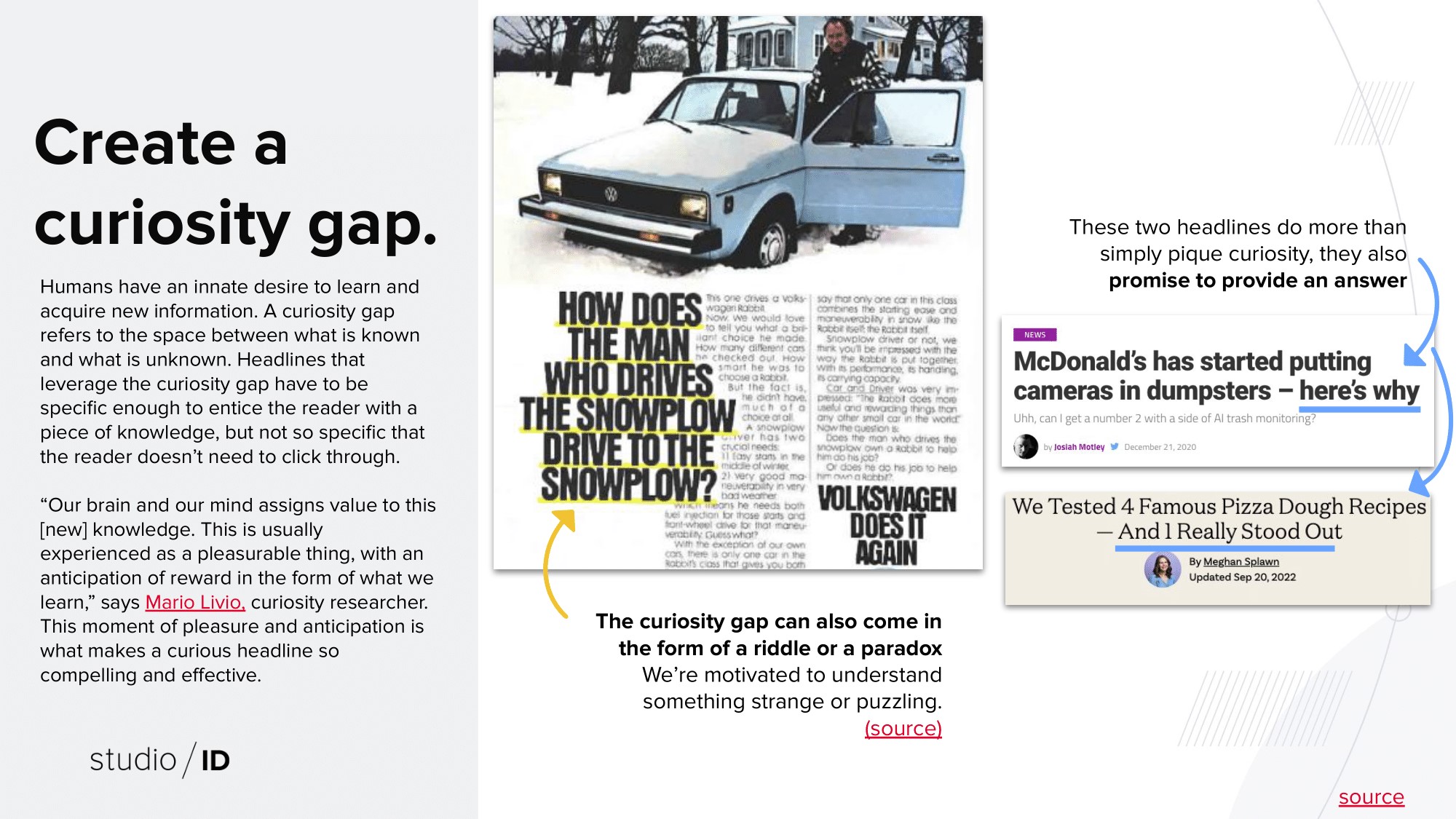 Sources: 2023 studioID Headline Research & Analysis | Marketing Examples Database
Sources: 2023 studioID Headline Research & Analysis | Marketing Examples Database
There are two types of curiosity gaps that headlines can tap into: perceptual curiosity and epistemic curiosity.
Perceptual Curiosity
Perceptual curiosity is our desire to understand something strange or puzzling. The Volkswagen headline on the left is a good example of this by posing a peculiar, yet thought-provoking question the reader does not know the answer to.
Epistemic Curiosity
Epistemic curiosity is simply the desire to learn something new. In the above graphic, the two headlines “McDonald’s has started putting cameras in dumpsters — here’s why” and “We Tested 4 Famous Pizza Dough Recipes — And 1 Really Stood Out” pique a reader’s curiosity to click and uncover the truth being teased in the headline.
It’s worth noting that because the curiosity gap technique is so commonly used in headlines, it’s essential to reinforce the promise of bridging the gap. The aforementioned headlines not only pique curiosity, but also promise to deliver on an answer.
This moment of anticipation punctuated with a reveal and ensuing pleasure is what makes a curiosity-gap headline so compelling and effective.
Harness the Underdog Effect
According to consumer research, underdog stories have a positive impact on brand loyalty and purchase intent. As naturally social creatures, people form a bond with an underdog because it makes them feel needed.
How to Use the Underdog Effect
Sources: Mark Ritson via Marketing Mag | Marketing Examples Database
A 1960s Avis campaign positioned the rental agency as second-best to Hertz, with the tagline “When you’re only No. 2, you try harder.” This tagline effectively captured attention, promised a superior experience over Hertz, and generated brand loyalty with consumers rooting for an underdog trying to fight their way to the top.
Another variation of this technique is to create a headline that implicates a clear villain in the story, as our brains naturally seek fairness and justice. This is evidenced in the above-pictured headline from Greenlight Bookstore: “Buy Books From People Who Want to Sell Books, Not Colonize the Moon.”
This technique is especially effective for consumers who identify as underdogs. Ultimately, it comes down to knowing your audience. This strategy might be super effective when targeting under-resourced K-12 teachers, but not as effective if targeting bankers on Wall Street.
Apply the Social Identity Theory
Another technique to consider when crafting headlines is to directly implicate the reader. By using language that helps readers self-identify as part of a larger group, community, or persona, the headline taps into something called “social identity theory.” This theory suggests that people derive a sense of self-worth from belonging to a group.
However, this technique goes beyond simply categorizing readers as millennials, project managers, or busy moms. It aims to tap into something that readers may not have even articulated yet — a specific pain point, insecurity, or motivator. When done effectively, the headline validates these emotions and resonates with the reader on a deeper level.
How to Use the Social Identity Theory
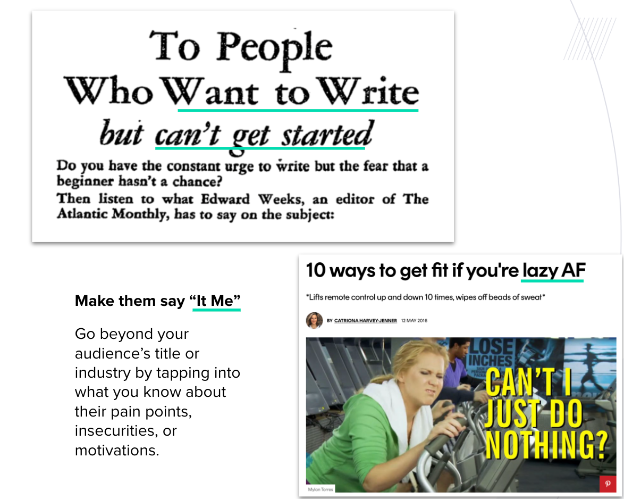
By tapping into social identity theory, headlines not only capture readers’ attention but also form a deeper connection between the reader and the brand. The reader associates the brand with feeling understood and validated.
3. Adopt an Archetype
Another effective method to craft headlines is via the use of brand archetypes. This technique explores how your headline can reflect your brand’s spirit, tone, and voice. To put this into simple terms, let’s consider who yourbrand would be at a dinner party. There are four archetypes you can use to guide your headline writing:
The Conversation Starter
The ’conversation starter’ archetype is someone who initiates discussions and can be somewhat provocative, although not always deliberately so. They hold a firm position or point of view on a topic and are unafraid to express their thoughts. Moreover, they excel at kick-starting conversations without necessarily pushing an agenda.
The Conversation Starter as a Brand
These personalities are relatively uncommon in the branding world, which presents a significant opportunity for brands to establish a distinctive editorial voice in essential conversations. A ‘conversation starter’ brand identifies and dominates ownable conversations.
“Ownable conversations are editorial perspectives that highlight a brand’s unique value and category expertise to their audience. As “big ideas” they allow for a range of expert-driven discussions, industry nuances, and clear perspectives that help to increase market awareness and build brand reputation.”
— Lieu Pham, VP Global Strategy, studioID
Risks will be dependent on industry, but by and large, brands that can infuse their content with more personality and opinion on relevant topics can truly set themselves apart.
Headlines under the ‘conversation starter’ archetype might:
-
Flip the script on a common narrative
-
Make a provocative assertion
-
Tease a novel idea or bizarre story
-
Elevate an unexpected fact
-
Cover something newsworthy or timely
The Problem Solver
The problem solver archetype aims to provide value and helpful resources. They are a facilitator who assists the other guests in overcoming challenges without an agenda of their own.
The Problem Solver as a Brand
The problem solver is a well-known archetype in the world of content marketing, particularly in the B2B domain. The focus is on identifying and addressing the pain points and challenges faced by the target audience, which extends beyond merely promoting the brand’s products.
The objective is to contextualize the brand’s solutions where they are relevant and, most importantly, offer useful and practical content that supports the audience’s journey.
Headlines under the ‘problem solver’ archetype might:
-
Lead with the challenge
-
Tap into an audience pain point
-
Lead with social proof such as a case study
-
Elevate actionable outcomes
The Teacher
Although the teacher archetype can sometimes be mistaken for the problem solver, it is quite distinct. Teacher archetypes are either experts themselves or adept at facilitating conversations with experts.
The Teacher as a Brand
A brand’s approach typically involves presenting robust evidence, data, and proof points to support their arguments, and they are fond of using phrases like “according to our study” or “as our experts have shown.” Above all, the teacher archetype prioritizes authority, credibility, and facts in their communication style.
Headlines under the ‘teacher’ archetype might:
-
Offer how to’s, breakdowns, and comprehensive guides
-
Establish credibility, authority, and expertise (“backed by science”, “according to experts”, etc.)
-
Use accessible and approachable language
-
Promise to upskill or illuminate the reader
The Futurist
The futurist is forward-thinking, innovative, and achievement-oriented. They provide elevated thoughts on a topic and challenge others’ lines of thinking.
The Futurist as a Brand
A futurist brand provides future-focused perspectives such as industry predictions, forecasts, or trend reporting. They produce content that highlights relevant innovations, technological developments, cultural trends, economic shifts, or geopolitical events. Through data, research and analysis they position they build their brand reputation and credibility.
Headlines under the ‘futurist’ archetype might:
-
Incorporate numbers and data
-
Highlight strategies or insights for navigating transition
-
Establish them as a thought leader in their industry
The truth is, most brands are a hybrid of these core archetypes. Some days you’re the problem solver, and other days you’re the futurist, and so and so forth. But by identifying which archetypes make sense for your brand and choosing the best one to use for a given piece of content, you’ll arrive at a headline that ignites your audience’s interest.
Whether you’re relying on data, psychological principles, nods to pop culture, playing the role of an archetype, or a blend of it all — you’re now equipped to craft the perfect headlines for your content.
![]()



